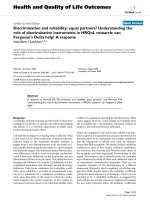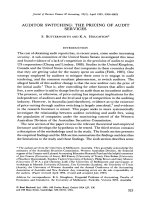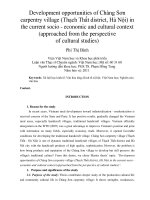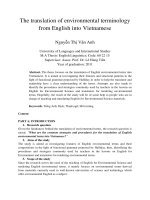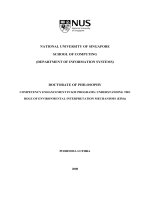Developing countries and emission reduction commitments understanding the drivers of environmental impact
Bạn đang xem bản rút gọn của tài liệu. Xem và tải ngay bản đầy đủ của tài liệu tại đây (435.17 KB, 68 trang )
DEVELOPING COUNTRIES AND EMISSION
REDUCTION COMMITMENTS
Understanding the Drivers of Environmental Impact
Ruchika Saluja
{B.A. (Hons) Economics, University of Delhi,
MSc Environmental Management, NUS}
A Thesis Submitted for the Degree of
Masters of Social Sciences (by research): Economics
Department of Economics
National University of Singapore
2007
Acknowledgements
I would like to express my sincere thanks to my supervisor Dr Chang Youngho
for his constant support and guidance. A special thanks to my friend and husband,
Nalin Rajaure, who helped me through all the times when I gave up on myself.
Without his encouragement, this thesis would have never seen its completion.
Last but not the least I would like to thank my family for always being there for
me and cheering me up, despite the large physical distance.
ii
Table of Contents
1. Introduction……………...………………………………......................................
1
2. Review of Literature
2.1
Introduction…………………………………………………….......... ……… 7
2.2 Developing Countries and the Global Climate Policy……………………….. 7
2.3
The Equal Per Capita Emissions Approach………………………………….. 10
2.4
Identifying the Drivers of Climate Change………………………………….. 14
2.5
Population, Affluence and Technology as Drivers of Climate Change…….. 16
2.6
Individual Time Series Analysis: Need and Benefits…………………………… 22
3. Developing Countries and the Per-Capita Emissions Approach
3.1
The Science and Economic of a Propitious Climate Change Policy…....... 26
3.2
A Modified Per-Capita Emissions Approach.............................................. 32
3.3
Results and Discussion…………………………………………................ 36
4. Identifying the Drivers for Climate Change
4.1
Introduction………………………………………………………............... 42
4.2
The STIRPAT Model: An Analytical Approach………………………....... 43
4.3
Data Sets…………………………………………………………………… 45
4.4 Regression Results, Analysis and Discussion………………………………49
5. Conclusion
5.1
Concluding Remarks………………………………………………………. 58
5.2
Extending the study further…………………………………………………59
References…………………………………………………………………………….. 61
Appendix A: Error Correction Model Results for Model 1...... ............................... 63
Appendix B: Error Correction Model Results for Model 2...... ............................... 64
Appendix C: The ARCH LM Test – Model 1……….…………………………….... 65
Appendix D: The ARCH LM Test – Model 2……….…………………………….... 66
Appendix E: Level form regression results-Model 1……………………………….. 67
Appendix F: Level form regression results-Model 2……………………………….. 68
Appendix G: Data Sets……………………………………………………………….. 69
iii
SUMMARY
While it is true that the emissions of greenhouse gases (GHGs) have come
disproportionately from industrialized countries, at the same time, the
consequences of an altered environment due to climatic changes are not
distributed in the same proportion. The Kyoto Protocol, although a significant
step forward in the climate change agendas, is often criticized for its ambitious
short term targets and full responsibility only for developed countries that
seriously undermines its effectiveness. It has become increasingly imperative to
consider potential strategies that allow for the inclusion of developing countries
while at the same time are in agreement with the principle of historical
responsibility.
Most developing countries view participation in a global climate change treaty as
being synonymous with drastic emission cuts and decelerated economic
development, and are therefore reluctant to be a part of any binding international
climate change treaty. A second dimension to this problem is that for developing
countries, addressing climate change, at the national level, poses a fundamentally
different challenge with most of these countries continuing to increase emissions
as they strive for economic growth. Despite the overwhelming scientific evidence
for the link between anthropogenic sources and climate change impacts, there is
still a limited understanding of the specific forces driving those impacts. In many
cases, a response to climate change, in developing countries is not forthcoming
simply due to a lack of understanding or ability to align national climate change
policies with the global agenda
Keeping in view the above, this study contributes in two ways
i)
Briefly discusses a plausible burden sharing arrangement - the per capita
emissions approach - for an all encompasssing global climate change
treaty such that negotiations are reduced to two manageable variables.
iv
ii)
Conducts a country wise empirical analysis for analyzing the drivers of
environmental impact, and their trends, in a sample of 6 developing
countries. Our assessment is informed by the well known stochastic
reformulation of the IPAT identity, known as the STIRPAT model
The study undertakes a brief analysis the per capita emissions approach, often
touted to be as a plausible solution to the dilemma of designing an all
encompassing global climate change policy. The approach is modified to include
the essential scientific and economic elements of any global climate change
solution. The analysis of this modified approach shows that developing countries
need not undertake drastic emissions cuts, while being committed to an
international climate change solution, such as the proposed one.
While addressing the second objective, the thesis undertakes a time-series
analysis within the framework of the STIRPAT model to identify for variations
that exist in the relative influence of the drivers of environmental impact across
developing countries. Results of the analysis reveal that while population and
affluence are the prime drivers of impact, their impact varies significantly across
the developing countries. Moreover, population does not exert a unitary impact on
emissions as is often simplistically assumed in most studies that undertake such
an analysis. The impact is mostly in excess on 1 and in some cases, as the analysis
reveals, is also in excess of 2.
Being aware of the role that each of these drivers play in the socio-economic and
environmental context within each country, can provide a useful starting point for
designing a national response to an international agenda.
v
List of Tables
Table 1
Table 2
Table 3
Table 4
Table 5
Table 6
Five equity principles and their implications for global burdensharing
Per Capita Emission Entitlement
Definition of variables used in the study
ECM results (Model1)
ECM results (Model 2)
Percentage contribution to GDP by Industrial Sector (China,
Thailand, Indonesia)
List of Abbreviations
CO2
Carbon dioxide
GDP
GHG
GDP
Gross Domestic Product
Greenhouse gases
Gross Domestic Product
IPCC
ppm
STIRPAT
Inter-Governmental Panel on Climate Change
Parts per million
Stochastic Impacts by Regression on Population, Affluence and
Technology
vi
CHAPTER 1: INTRODUCTION
The threat imposed by climate change, a conjecture only a decade ago, seems a
reality now more than ever. The awareness of global warming concerns amongst
the international community is reflected in the enormity of research literature that
exists across the spectrum of science, economics and sociology. At the
institutional level, the debate on climate change is largely dominated by two interrelated issues. Firstly, the future of the Kyoto Protocol, keeping in view its current
limitations. Secondly, designing an umbrella framework that includes a burden
sharing arrangement suitable for both developing and developed countries while
giving due consideration for their differentiated economic conditions. The second
concern forms the baseline agenda for this thesis.
As has been seen during recent climate policy negotiations, a critical
element has been that of ‘suitability and fairness’ with respect to the treatment
accorded to developing and developed states. On the other hand, lack of
consensus on the ultimate objective such as maximum allowable temperature
change, absolute level of emissions, concentration levels for GHG or the cost of
reduction have also emerged as roadblocks in the process. In addition to this,
there is a strong resistance to formal participation in a global climate change
treaty, by most developing countries, on grounds of historical responsibility.
Formal participation is more than often treated as being synonymous with drastic
cuts in emissions. There is no doubt that in the case of developing countries,
-1-
addressing climate change, at the national level, poses a fundamentally different
challenge with most of these countries continuing to increase emissions as they
strive for economic growth. Therefore direct emission reduction for GHG
reduction is not a viable option.
Our analysis for a solution to the above problem centers around the fact
that there exist multiple drivers capable of exerting a significant influence on
environmental impact. Therefore a potential way of dealing with the issue could
be to assess the drivers of GHG emissions and their related trends in developing
countries. Information regarding the same can help illuminate the particular
national circumstances faced by the country and inform the international
community’s policy response. At the same time, such information can serve as a
useful starting point for identifying the natural synergies between climate
protection and development priorities and consequently aligning the national
climate change policy with the international environmental agreement.
Keeping in view the above, this thesis adds to the literature on economics of
climate change in the following two ways:
iii)
Briefly discusses a plausible burden sharing arrangement - the per capita
emissions approach - for a global climate change treaty such that
negotiations are reduced to two manageable variables.
iv)
Conducts a country wise empirical analysis for analyzing the drivers of
environmental impact, and their trends, in a sample of 6 developing
-2-
countries. Our assessment is informed by the well known stochastic
reformulation of the IPAT identity, known as the STIRPAT model
The thesis is structured as follows:
Chapter 2 provides a summary of the review of literature undertaken to explore
the current work addressing these two objectives. It begins with providing an
insight into the per capita emissions approach. The latter part of the chapter
focuses on giving an overview of the existing studies on anthropogenic impacts
and climate change and introduces the STIRPAT model, the basis for our
empirical analysis model.
Chapter 3 begins with a brief discussion on the science and economics of a
propitious climate change policy. It then outlines the per-capita emissions
approach. A statistical exercise is then conducted to calculate short and long term
emission entitlements for the developing countries, under the proposed modified
per capita emissions approach. The baseline model, as suggested by Gupta and
Bhandari (1999), is modified to include current scientific and economic
considerations. The emission reduction commitments for a chosen sample of five
developing countries are outlined under the revised scenario. T
Chapter 4 provides an empirical analysis identifying the relative importance of
each of the three drivers of environmental impact i.e population, affluence and
technology for a sample of six developing countries within the STIRPAT
-3-
framework. Most studies until now have relied on the panel data fixed effects
model where countries are categorized according to their developed or developing
country status and the drivers of environmental impact are assumed to have
homogenous effects for countries in the same group. However the dynamics of
today’s global economy implies that even among countries at similar levels of
income, identical drivers of environmental impact might differ in their relative
influence on the natural environment due to differences in the socio-economicpolitical environment within which these operate. The STIRPAT model in
Chapter 4 is based on an individual time series analysis using data for 33 years,
for each of the chosen countries, to identify the relative intensity of influence of
population, affluence and technology on environmental impact. The chosen
sample of countries includes India, Pakistan, Philippines, Thailand, Indonesia and
China.1.
Chapter 5 presents the conclusion and recommendations to the study.
The findings in Chapter 3 results confirm that in the presence of an
adjusted per-capita emissions approach, such as the proposed one, all developing
countries can significantly increase their emissions during the next two decades.
In the case of some countries, this approach lays down an emission target that is
almost similar to the targets set by the national governments themselves. In
general, there is a sufficiently large period available for the developing countries
to adjust to an emissions target different from the BAU scenario. In addition to
1
For selection criteria, refer to Chapter 4.
-4-
that, most developing countries can also stand to financially benefit from the
generation of ‘hot air’ and the possibility of selling excess allowances. These
earnings can then be reinvested into cleaner technologies and consequently
generation of more permits.
Our findings in Chapter 4 confirm the results of earlier studies and refocus
attention on population and material affluence as principal threats to sustainability.
However in contrast to the results derived from panel data models, our outcome
highlights an important point that anthropogenic drivers of environmental impact
do not exert a similar influence on the environment for all countries that lie within
the same income group. Moreover, our results also contradict the conclusion
arrived at by most studies that emission elasticity with respect to population is
unity. In such a case, designing uniform policies for countries by categorizing
them only on the basis of their income levels, as done by previous studies, might
not provide a useful and workable solution for ameliorating climate change.
Instead, individual country cases should be considered, as far as possible, to allow
for an effective international climate change agenda.
-5-
MOTIVATION
Gupta and Bhandari (1999): ‘An effective allocation criteria for CO2 emissions’ Energy Policy
(27):727-736
Shi, Anqing (2003). ‘The impact of population pressure on global carbon dixide emissions,
1975-1996: evidence from pooled cross country data’ Ecological Economics 44 (2003) 29-42
York et al (2003) ‘STIRPAT, IPAT and ImPACT: analystic tools for unpacking the driving
forces of environmental impacts’ Ecological Economics 46 (2003) 351-365
The growing reality of the threat of climate change as made increasingly evident by
unprecedented weather events.
The intensifying debate over developing country participation in any treaty succeeding the
Kyoto Protocol fuelled further by the economic growth achieved by India and China during
the last few years
Objective 1
Briefly discuss a plausible burden sharing
Objective 2
Conduct a country wise empirical analysis for
arrangement - the per capita emissions
analyzing
approach - for a global climate change
impact, and their trends, in a sample of 6
treaty such that negotiations are reduced
developing
to two manageable variables.
framework.
Methodolog
the
drivers
countries
of
within
environmental
the
STIRPAT
Methodology
Introduce the equal per-capita emissions
Highlighting the relation between
approach, that has received much
environmental impact and its drivers:
consensus from both developing and
population, affluence and technology.
developed countries
Understanding the STIRPAT model and
Outline the essential scientific and
collating time series data
economic considerations for any future
Undertake an empirical time series analysis
climate change strategy.
to examine the intensity of impact of
Incorporate the above into a modified per-
population, affluence and technology on
capita emission approach scenario and
environmental impact in developing
assess the obligations for developing
countries.
countries.
Baseline model: as proposed by Gupta and
Bhandari (1999)
-6-
CHAPTER 2: REVIEW OF LITERATURE
2.1
Introduction
This chapter focuses on the literature review undertaken to accomplish the study’s
objectives. As mentioned in Chapter 1, this study seeks to serve a two-pronged
objective. Firstly to discuss a plausible burden sharing arrangement – the per
capita emissions approach. Secondly to provide an empirical analysis for
analyzing the drivers of environmental impact in developing countries using a
time series approach. Section 2.2 provides a brief insight into the arguments put
forward favoring the inclusion of developing country in a global climate change
treaty. Section 2.3 goes on to discuss the equal per capita emissions approach and
the proposed amendments to the same. Section 2.4 details the literature review
centered about the second objective. It gives an overview of the existing studies
on anthropogenic impacts and climate change and introduces the STIRPAT model,
the basis for our empirical analysis model. Section 2.5 briefly discusses the
benefits of a time-series approach while analyzing the drivers of climate change.
2.2
Developing Countries and the Global Climate Policy
With the expiration date of the Kyoto Protocol drawing close, the focus has turned
increasingly to the question of developing country emissions. Consider the
following facts. The compounded annual growth rate (CAGR) of CO2 equivalent
emissions from India, China & Brazil during 1990-2000 shows an overall increase
by 4.2, 5 and 6 per cent per annum respectively. In comparison to this, the GAGR
figures for USA and Japan stood at 2%. According to the International Energy
-7-
Outlook 2006, the fastest growth until 2025 is projected in developing countries
whose collective emissions are projected to rise 84% (compared to the 35%
growth for industrialized countries). 2 One of the most contentious issues in the
debate over global climate change is the perceived divide between the interests
and obligations of developing and developed countries. Arguments of historical
responsibility demands that developed countries – the source of most past and
current emissions of GHGs - act first to reduce it. While it is true that the
emissions of GHGs have come disproportionately from industrialized countries, at
the same time, the consequences of an altered environment due to climatic
changes are not distributed in the same proportion. Addressing climate change in
this group of countries poses a fundamentally different challenge with emission
reduction not a viable option for most in the short run. With per capita income
levels much below developed states, developing countries can be expected to
continue to increase emissions as they strive for economic growth. Threatened by
global warming, while most countries agree on the importance of global
greenhouse gas emission reductions, there is still considerable disagreement over
the distributional issues that any successor agreement will involve.
Absence of economies with rapidly rising emissions - such as those of
India and China – from an international climate change treaty implies that even if
Kyoto was fully implemented, it is possible that emissions would continue to
exceed removal and GHG concentrations would continue to rise. The inclusion of
developing states will be essential to overcome this problem of ‘leakage’ i.e the
2
This will take the developing country share of global emissions up to 55% from 48% in the year 2000
-8-
possibility that reductions in emissions in industrialized countries under any
climate change agreement would be partially offset by emissions in nonparticipating developing countries. Additionally, global efficiency considerations
favor the inclusion of developing countries in any international climate change
agreements since the cheapest source of CO2 emissions abatement are found, not
in Annex B countries, but in the developing economies. So can the existing Kyoto
Protocol provide the suitable outcome for an international climate change
agreement that can serve the interests of both developing and developed countries?
There is a growing scientific and economic consensus on the need for a
credible approach to address the threat of climate change. Although the Kyoto
Protocol represents a consistent step forward in the international response to the
dilemma of global warming, it suffers from some inherent drawbacks that
seriously undermine its effectiveness. During the last few years, serious questions
have been raised regarding the Protocol’s ability to induce sufficient participation
and compliance. According to Barrett and Stavins (2002) the Protocol’s
shortcomings can be attributed to three key architectural elements: ambitious
short-term targets, full responsibility (targets) only for industrialized countries and
absence for effective instruments for promoting compliance and participation. The
need for amending the Kyoto Protocol is as critical as is the necessity for
comprehensive participation from both the developed and developing countries.
-9-
2.3
The Equal Per Capita Emissions Approach
‘….on the basis of equity and in accordance with their common but
differentiated responsibilities and respective capabilities, parties should act
to protect the climate system’
Article 3, Principles, UNFCCC
Limiting global warming to avoid the worst of the potential negative impacts will
require a drastic change in the emissions trajectories of both rich and poor
countries. One of the defining issues in discussing varied burden sharing
approaches has been whether and when developing countries should take on
emission targets and how should differential commitments be set for the
developing and the developed states. The Kyoto Protocol adopts the ‘target and
time-table’ approach that sets specific goals in terms of emission targets at given
points in time. During the last few years, varying burden sharing rules, centered
about considerations of equity and fairness, have been suggested for restricting
emissions in developing countries. Rose and Stevens (1993)3 distinguish between
‘allocation based’ and ‘outcome based’ equity principles. In the context of climate
change agreements, those based on the former equity principle focus on a fair
initial allocation of property rights to GHG emissions, using criteria such as
population, GDP and historical emissions or a mixture of them. Agreements based
on the ‘outcome based principle’ focus on a fair outcome of climate protection
strategies such as the equalization of net cost per GDP or the requirement that
mitigation efforts should not affect the developing states adversely.
3
Rose, A and B. Stevens (1993) ‘The Efficiency and Equity of Marketable Permits for CO2 Emissions’
Resource and Energy Economics 15(1), pp117-146
- 10 -
Traditionally converging per capita emissions has been favored by most
developing countries. This has, in the past, been advocated by the governments of
China, India, the Africa Group, France, Belgium and Sweden amongst others. It
requires all countries to participate and per capita emission allowances converge
to the same level until a predefined date so that global emissions lead to a
predefined stabilization level4. Allowing for equal emissions per capita is a direct
application of egalitarian equity. However this approach has been criticized for its
over simplicity in treating a great variety of national circumstances. As pointed
out by Stiglitz et al (2001), a distribution of emissions on the basis of population
would imply a large emission reduction for the developed, less populated
countries. They further point out that counties that fail to control their rate of
population would be effectively ‘rewarded’ by getting extra entitlement to
emissions. Proponents of this approach suggest that with small adjustments,
reflecting vertical equity, in the short to medium term, the per capita emissions
approach can serve as a successful solution to the current impasse in the climate
negotiations. A review of the academic literature reveals the various amendments
that have been suggested to the straightforward per-capita emissions entitlement
approach. Some authors recommend that a long term per-capita convergence
target can be identified and each person can be allocated an entitlement based on
the same. The target itself could be flexible and subject to revision as more
scientific information becomes available
4
Grübler and Nakićenović (1994) use this rule to calculate the distribution of the global emission
entitlements of 13 world regions with a target of 38% reduction in CO2 emissions in 2050 compared to
1988.
- 11 -
Another approach representing such an altered framework is the
‘Contraction and Convergence’ approach. Based on the principle of historical
responsibility and equality of rights, it can be best defined as a future international
climate regime based on converging per-capita emissions in conjunction with a
gradual decrease in global emissions towards stabilization of GHG concentrations
(Meyer, 2000). Originally conceived by the Global Commons Institute in the
early 90’s, it is based on two principles: First, contraction of global carbon
emissions in order to achieve a pre-defined CO2 concentration target; Second,
convergence of per capita emissions across the global population. In the short run,
this tantamounts to a reduction for the developed states, while those in the
developing countries are able to increase their per capita emissions in order to
develop economically. Eventually per capita emissions converge at a per-capita
level. According to Berk et al (2001) 5 , a later date of convergence is
disadvantageous to developing countries since it results in less cumulative
emission permits.
Refinements to the Contraction and Convergence approach have been
suggested by many authors. Swen Bode (2003)6 allocates future emission rights
on the basis of equal per capita emissions over time, such that emissions per
capita are taken into account both during their evolution and at the time of
5
Berk, Marcel. M. and Michel den Elzen. (2001) ‘Options for differentiation of future commitments in
climate policy; how to realize timely participation to stringent climate goals’ Climate Policy, Vol(1)
6
Bode, Swen. (2003) ‘Equal Emissions per Capita over Time-A Proposal to Combine Responsibility and
Equity of Rights’. HWWA Discussion Paper
- 12 -
allocation. A recent study by Hohne et al.(2006)7 recommends a ‘common but
differentiated convergence’ approach in response to the concern that emission
reduction obligations in advanced developing countries are delayed and reduced
in comparison to the obligations for the Annex-1 countries. Gupta and Bhandari
(1999) also favor an equal emissions per capita outlook for all countries in the
long run. However, keeping in view considerations of historical responsibility as
well as horizontal and vertical equity, the authors suggest that an efficiency index
should be included, within the equal per capita model, to avoid prescribing
abruptly declining emission entitlements for Annex 1 countries. They further go
on to argue against the claim that a formulation linked to future population may
influence developing countries to unduly increase their population to gain higher
entitlements, keeping in view the prevalent policies to limit population, poverty
alleviation and the recognition of limits to availability of resources.
The Contraction and Convergence framework integrates the need for
climate change policy to be based on comprehensive participation and a clear
scientific foundation by incorporating provisions that allow for differentiated
reduction commitments and pre-fix a global concentration target. It makes an
attempt to look beyond the egalitarian perspective to reconcile and incorporate
available scientific knowledge along with economic principles. At the same time,
it also allows for developing country participation without affecting their pursuit
of economic development and poverty reduction. Ultimately almost any
7
Hohne. E., M den Elzen and M Weissb (2006) ‘Common but differentiated convergence (CDC): a new
conceptual approach to long-term climate policy’ Climate Policy 2006; 6(2): 181-199
- 13 -
conceivable long term solution to the climate problem will incorporate some
crude variation of the contraction and convergence philosophy. Chapter 3
discusses one such plausible solution that incorporates other essential scientific
and economic considerations central to any climate change strategy.
2.4
Identifying the Drivers of Climate Change
Successful implementation of a global climate policy regime will require active
participation of national governments as it is they who will determine how an
international climate change agreement is translated at the domestic level. Despite
the overwhelming scientific evidence for the link between anthropogenic sources
and climate change8 impacts, there is still a limited understanding of the specific
forces driving those impacts. The Ehrlich-Holdren vs Commoner debate in the
early 70’s firmly established that population, affluence and technology played a
significant role in shaping environmental impacts. Many studies have discussed
this relationship using diverse modeling approaches. The IPCC too has, on more
than one occasion, pointed out that projections of long term emissions growth
depend heavily on assumptions about such critical factors as economic and
population trends and the rate of technology development and diffusion. Infact,
the IPCC has developed four ‘families’ of scenarios incorporating different sets of
assumptions about these factors. Yet there remains much scope for further
empirical analysis. This has also been reinforced by the US National Research
Council in one of their recent reports on climate change where they say that
8
Global Environmental Change: Research Pathways for the Next Decade (1999). Committee on Global
Change Research, National Research Council, National Academy Press, Washington D.C (1999)
- 14 -
“Although physical and natural scientists have developed sophisticated
models of biogeochemical and other global processes, the dynamics of the
anthropogenic
drivers
of
global
environmental
change
are
not
fully
understood”
One reason for this is the absence of a set of refined analytic tools. Lack of
long-term credible data relating to emissions and change in the concentration of
GHG over the last 2-3 decades etc creates further barriers.9 York et al (2003) have
pointed out to the paucity of appropriate analytic techniques and models that
could allow for a precise specification of the functional form of the relationship
between anthropogenic driving forces and environmental impacts, to be a prime
reason inhibiting social and economic enquiry of the subject. Secondly, the
principal tools commonly utilized in climatic research are the two large scale
structural models i.e a) general circulation models (GCMs) and b) integrated
climate economy models (DICE Model by Nordhaus, 1992) 10 . These utilize
specialized softwares and supercomputers to perform simulations of global
weather. However a significant drawback of such models is their large cost as
well as their complex and time consuming construction. The correct specification
of the model is also open to considerable debate. As discussed by Knapp and
Mookerjee (1996), keeping in view the perceived need for policy making,
researchers have begun to rely on simple time-series techniques to provide some
9
A proper awareness of environmental issues, in the academic world and at the level of institutional
policies and international organization is quite recent and dates back to the mid 70’s. Climate change
discussions came to the forefront only about a decade later.
10
Nordhaus, W (1992) ‘The DICE Model: Background and Structure of a Dynamic Integrated ClimateEconomy Model of the Economics Of Global Warming’
- 15 -
insight into the interconnectedness between global temperatures and the relevant
policy variables. The empirical analysis conducted in this study seeks to make a
contribution to that body of work.
2.5
Population, Affluence and Technology as Drivers of Climate Change
A review of the literature on this subject reveals that questions relating to the
relationship between climate change impacts and anthropogenic sources have
been addressed across the spectrum of social and natural sciences. Two strands of
empirical work can be identified under this topic. The first being descriptive in
nature and the second takes an empirical approach. Descriptive studies tend to
attribute variations in CO2 emissions to changes in population, affluence and
energy intensity. (Engleman-1994; Meyerson-1998). The second strand adopts an
empirical approach by focusing on the link between CO2 emissions and economic
growth, regressing emissions on affluence, population and other predictors.
A large amount of attention has been devoted to the casual link between
population and environmental impact. Many empirical studies have explored the
question whether increases in the atmospheric concentration of CO2 and other
GHGs can be largely attributed to accelerated population growth and have
analyzed the underlying statistical relationship between the two. Traditionally
researchers have assumed a unitary elasticity of emissions w.r.t population growth.
Engelman (1994) adopts a descriptive approach to explore this relationship. His
study plots the long term trends in global CO2 emissions and population. Similar
- 16 -
rates of growth of both variables lead him to hypothesize that population growth
has been a major factor explaining rising emissions. Using the Granger test of
causality and other comprehensive error-correction model, Knapp and Mookerjee
(1996) also examine this relationship using global annual data for 1880-1989.
Their results suggested a lack of any long-term equilibrium relationship but imply
a short-term dynamic relationship from CO2 to population growth. The causal link
between population and global carbon dioxide emissions has also been examined
by Shi (2001;2003) by using data for 93 countries. His study concludes that global
population change during the last two decades was more than proportionally
associated with growth in carbon dioxide emissions. The elasticity of emissions
with respect to population was nearly 2 for developing nations, while it was seen
to be less that one for high income countries. Furthermore, impact of population
change on emissions is more pronounced in developing countries as compared to
developed countries. A similar conclusion was arrived at by a study done by
O’Neill et al.( 2001)11
The importance of population and economic growth as emission drivers has also
been highlighted, by the World Resources Institute 12 , using a decomposition
analysis technique. According to their report released in 2005, economic growth
(measured as increases in GDP per capita) had the strongest influence on emission
levels, usually putting an upward pressure on emissions, in cases as diverse as the
U.S, India, Indonesia, Australia, and Iran.
11
O’Neill, Brian C., F. Landis MacKeller, Wolfgang Lutz. (2001). Population and Climate Change,
Cambridge University Press.
12
Navigating the Numbers, Published by the World Resources Institute (14)
- 17 -
One of the earliest attempts to explain the dynamics between
environmental impact, population and human welfare was made by Ehrlich and
Holdren (1971). According to them, population growth causes a disproportionate
negative impact on the environment. Conventional view, on the other hand, holds
that affluence is a prime driver of higher CO2 emissions. It is a priori not evident
that population growth leads to higher environmental degradation. Production
technologies, consumption patterns and technological progress play an equally
important role in determining the amount and type of emissions.
Economic and scientific research, over the last three decades has
culminated into a general consensus among policy makers and researchers alike
that posits that growth in population, affluence and technology are jointly
responsible for environmental impacts. This consensus is best manifested in the
simplified identity known as IPAT, that emerged out of the Ehrlich & Holdren
(1971) and Commoner (1972) debate. The ‘IPAT equation’, as it is popularly
known, states that environmental impact (I) is the product of population (P),
affluence (A) and technology (T):13
I = P * A*T
(….2.1)
This simple formulation has been chosen by many scholars as a starting point for
investigating
interactions
between
population,
economic
growth,
and
technological development. (Dietz and Rosa, 1994, 1997; Mackellar et al., 1995;
York et al., 2003; Auffhammer et al., 2004). The specification of the IPAT model
13
The IPAT model represents the efforts of population biologists, ecologists and environmental scientists
to formalize the relationship between population, human welfare and environmental impacts.
- 18 -
makes clear that all of the driving forces do not influence impacts independently
of one another.
This mathematical identity has been typically used as an accounting equation in
which known values of I, P, and A are used to solve for T. However it does not
prove to be very useful for statistical analysis because of its interpretation of
statistical association as causation. The identity merely gives the proportionate
impact of environmental change by changing one factor and simultaneously
holding the other constant. The development of economic theory requires that
hypothesis about the macro-variables and environmental impacts be testable,
rather than being simply assumed within the structure of the model. In addition to
this, a key to understanding the relative importance of each of the driving forces
(P, A and T) is to model the effects of their rate or pace of growth. The same
might have greater environmental impacts than size per se.
In order to overcome this limitation, Dietz and Rosa (1994, 1997)
reformulated the IPAT equation as STIRPAT (Stochastic Impacts by Regression
on Population, Affluence and Technology) to meet statistical testing requirement
and to allow for non proportional effects from the driving forces. Their
specification used to perform the regression analysis was as follows
I t = aPt b Atc Tt d ei
(….2.2)
The model maintains the multiplicative logic of the IPAT framework. The
variables a-d can either be parameters or more complex functions estimates using
- 19 -



